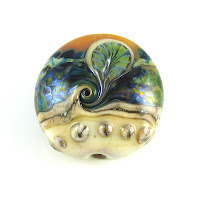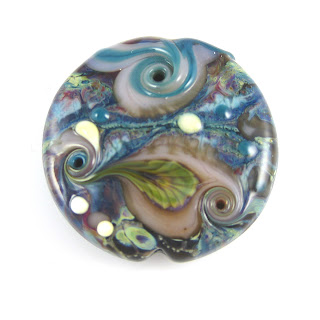1 - Plain, 2 - Plain (reduced), 3 - w/ Silver Leaf, 4 - w/ Silver Leaf (reduced & encased), 5 - w/ TerraNova2 Frit, 6 - w/ Silver Glass Frit (reduced), 7 - w/ Silver Glass Frit Stringer (encased), 8 - w/ Tuxedo, 9 - w/ Copper Green, 10 - w/ Opal Yellow, 11 - w/ Ivory, 12 - w/ White
Here, I've put silver leaf over the bead on the left. The silver has dispersed, and has fumed the surface of the bead with a brown haze. In the bead on the right, the reduced and encased silver has turned a peachy colour. This is similar to the reactions I got with Thüringen Herb.
On top of Latte Macchiato, I had a hard time getting decent colour out of my TerraNova2 frit, but I really like what happened with the reducing silver glass frit in the bead on the right. The frit has bloomed and separated and fumed the bead a little to a yellowish tan colour.
There is no noticeable reaction between Tuxedo and Latte Macchiato. No bleeding and no weirdness. The Latte Macchiato looks paler against Tuxedo than it does with the other colours I tested it with.
There isn't really anything all that interesting about Latte Macchiato with Ivory or Latte Macchiato with White. The Latte Machiato sort of disappears on top of those colours, and the Ivory/White lines and dots are crisp and smooth.
Here are some other beads made with Latte Macchiato. I may add to these because I still have a little bit of this colour left.
Lauscha Latte Macchiato is sort of unlike the other Milky Way colours I have tested in terms of how it reacts with other colours. It ranges in colour from a soft peach to a yellow, depending on how much it is struck and the colour it is used with. Annealed, it is more like Thüringen Herb than it is like the Milky Way pinks.
Rods of Latte Macchiato are sort of shocky and splintery, so you need to be careful to heat it slowly. It also looks completely different going into the kiln than it does coming out, which is a little disorienting. Before annealing, this colour looks very translucent and peachy, but post-annealing, it is far more opaque, and displays colours in the range I mentioned above.
I achieved some interesting effects with Latte Macchiato, and while it is not among my favourite Lauscha colours, it is definitely appealing and worthy of further study.
Rods of Latte Macchiato are sort of shocky and splintery, so you need to be careful to heat it slowly. It also looks completely different going into the kiln than it does coming out, which is a little disorienting. Before annealing, this colour looks very translucent and peachy, but post-annealing, it is far more opaque, and displays colours in the range I mentioned above.
I achieved some interesting effects with Latte Macchiato, and while it is not among my favourite Lauscha colours, it is definitely appealing and worthy of further study.
Here, I've put silver leaf over the bead on the left. The silver has dispersed, and has fumed the surface of the bead with a brown haze. In the bead on the right, the reduced and encased silver has turned a peachy colour. This is similar to the reactions I got with Thüringen Herb.
On top of Latte Macchiato, I had a hard time getting decent colour out of my TerraNova2 frit, but I really like what happened with the reducing silver glass frit in the bead on the right. The frit has bloomed and separated and fumed the bead a little to a yellowish tan colour.
Here, I made frit stringer with my reducing silver glass frit blend and Latte Macchiato. I like this streaky effect a lot, particularly where the unfritted Latte Macchiato has struck to tan.
There is no noticeable reaction between Tuxedo and Latte Macchiato. No bleeding and no weirdness. The Latte Macchiato looks paler against Tuxedo than it does with the other colours I tested it with.
I expected Copper Green to separate on top of Latte Macchiato, and for the Latte Macchiato to help the Copper Green not sheen up the way the other Milky Way pinks did, but instead I got a reaction that is much more reminiscent of how Copper Green behaved with Thüringen Herb. The Copper Green has developed an army green patina, and has bled into the Latte Macchiato stringer design on the left-hand side of the bead lending it some mottled turquoise streakiness. The Latte Macchiato on the right-hand side of the bead looks more opaque and a little dirtier than it does in the other test beads.
On top of Latte Macchiato, Opal Yellow separates and develops a thin tranlucent line down the centre of the stringer lines I drew. On top of Opal Yelow, Latte Macchiato looks sort of diffuse and mustardy. The Latte Macchiato on the right-hand side of this bead looks deeper and peachier than it does on the other test beads.
There isn't really anything all that interesting about Latte Macchiato with Ivory or Latte Macchiato with White. The Latte Machiato sort of disappears on top of those colours, and the Ivory/White lines and dots are crisp and smooth.
Here are some other beads made with Latte Macchiato. I may add to these because I still have a little bit of this colour left.




















































